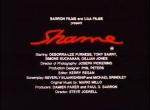
Latest Issues
AbstractHistoryArchive Description
In the vein of stranger-comes-to-town westerns, lawyer Asta Cadell (Deborah Lee Furness) is forced to stop in the small country town of Ginaborak to await parts for her motorcycle. The men of the town act very aggressively. The women cower. Asta is offered a place to stay by Tim Curtis (Tony Barry) a local mechanic and learns of the rape of his daughter Lizze (Simone Buchanan) the previous evening. As Asta befriends Lizze, she is horrified to discover that the men repeatedly gang rape the women of Ginborak.
Source: Reading Room, 'Shame', http://wwwmcc.murdoch.edu.au/ReadingRoom/film/dbase/2003/shame.htm (Sighted 7/10/11)
Publication Details of Only Known VersionEarliest 2 Known Versions of
Works about this Work
-
Classic Aussie Cinema and New Twists on Old Classics : Our Picks of December Streaming
2023
single work
review
— Appears in: The Conversation , 4 December 2023;
— Review of Shame 1988 single work film/TV ; Love Serenade 1996 single work film/TV ; Australia 2008 single work film/TV -
The Larrikin Girl : Challenging Archetypes in Australian Cinema
2022
single work
criticism
— Appears in: Senses of Cinema , October no. 103 2022;'Australian cinema has travelled a varied trajectory since its initial development in the late 19th century. The cinema reflected the developing social and cultural tropes of its time, as the concept of a distinct Australian identity began to form. But it is clear that a colonial history of Australian film focuses very clearly and emphatically along lines of class and gender. Rose Lucas notes that there is a “cluster of dominant, recognisable images in our cinema” which consists of the bushman, the ocker, the ‘mate’, and the ‘battler’, a series of male coded tropes which are stubbornly pervasive within this national cinema. These archetypes have trained a concentrated gaze upon masculinity in Australian cinema, but there has been little space in this cultural landscape for the development of archetypical women in Australia’s cultural history with very few valued traits that are specifically coded female. This resolutely masculine perspective seems to have shaped the nation and the national cinema, and Lucas’s observation highlights the key archetypes as embodied as masculine. But these archetypes, long the sole domain of masculine representation, also have historically encompassed female experiences. In this paper we identify the need to broaden such a framework, and by taking the most Australian and most masculine of forms – the larrikin – we argue that the larrikin girl has been hiding in plain sight across Australian film history.' (Introduction)
-
Steve Jodrell : No Shame
2018
single work
column
— Appears in: FilmInk , 26 June 2018; -
Regionalism in Audiovisual Production : The Case of Queensland
1994
single work
essay
— Appears in: Queensland Review , June vol. 1 no. 1 1994; (p. 47-54) 'A great deal has been made ofthe boom in audiovisual production based in southern Queensland (and to some extent in northern Queensland)in the 1990s. This follows a pattern throughout the so-called 'revival' period (since the early 1970s) in Australia which has seen successive moments of regional upsurge. In the 1970s, it was South Australia, under the energetic leadership of the South Australian Film Corporation, that saw many of the best feature films and several of the early historical mini-series of the early revival period made in that state (see, for example, Moran). During the early to mid-1980s,Western Australia, with the locationofbold production houses such as Barron Films and strong independent documentary traditions, offered robust regional opportunities, culminating in such memorable films as Shame and Fran.' (Introduction)
-
Classic Aussie Cinema and New Twists on Old Classics : Our Picks of December Streaming
2023
single work
review
— Appears in: The Conversation , 4 December 2023;
— Review of Shame 1988 single work film/TV ; Love Serenade 1996 single work film/TV ; Australia 2008 single work film/TV -
Steve Jodrell : No Shame
2018
single work
column
— Appears in: FilmInk , 26 June 2018; -
Regionalism in Audiovisual Production : The Case of Queensland
1994
single work
essay
— Appears in: Queensland Review , June vol. 1 no. 1 1994; (p. 47-54) 'A great deal has been made ofthe boom in audiovisual production based in southern Queensland (and to some extent in northern Queensland)in the 1990s. This follows a pattern throughout the so-called 'revival' period (since the early 1970s) in Australia which has seen successive moments of regional upsurge. In the 1970s, it was South Australia, under the energetic leadership of the South Australian Film Corporation, that saw many of the best feature films and several of the early historical mini-series of the early revival period made in that state (see, for example, Moran). During the early to mid-1980s,Western Australia, with the locationofbold production houses such as Barron Films and strong independent documentary traditions, offered robust regional opportunities, culminating in such memorable films as Shame and Fran.' (Introduction) -
The Larrikin Girl : Challenging Archetypes in Australian Cinema
2022
single work
criticism
— Appears in: Senses of Cinema , October no. 103 2022;'Australian cinema has travelled a varied trajectory since its initial development in the late 19th century. The cinema reflected the developing social and cultural tropes of its time, as the concept of a distinct Australian identity began to form. But it is clear that a colonial history of Australian film focuses very clearly and emphatically along lines of class and gender. Rose Lucas notes that there is a “cluster of dominant, recognisable images in our cinema” which consists of the bushman, the ocker, the ‘mate’, and the ‘battler’, a series of male coded tropes which are stubbornly pervasive within this national cinema. These archetypes have trained a concentrated gaze upon masculinity in Australian cinema, but there has been little space in this cultural landscape for the development of archetypical women in Australia’s cultural history with very few valued traits that are specifically coded female. This resolutely masculine perspective seems to have shaped the nation and the national cinema, and Lucas’s observation highlights the key archetypes as embodied as masculine. But these archetypes, long the sole domain of masculine representation, also have historically encompassed female experiences. In this paper we identify the need to broaden such a framework, and by taking the most Australian and most masculine of forms – the larrikin – we argue that the larrikin girl has been hiding in plain sight across Australian film history.' (Introduction)
Awards
- Western Australia,




